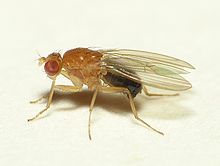Lordiphosa is a genus of fly in the family Drosophilidae.
| Lordiphosa | |
|---|---|

| |
| Lordiphosa andalusiaca | |
| Scientific classification | |
| Domain: | Eukaryota |
| Kingdom: | Animalia |
| Phylum: | Arthropoda |
| Class: | Insecta |
| Order: | Diptera |
| Family: | Drosophilidae |
| Subfamily: | Drosophilinae |
| Genus: | Lordiphosa Basden, 1961 |
Species
edit- L. acongruens (Zhang & Liang, 1992)[1]
- L. acuminata (Collin, 1952)[2]
- L. alticola Hu, Watabe & Toda, 1999[3]
- L. andalusiaca (Strobl, 1906)[4]
- L. antillaria (Okada, 1984)[5]
- L. archoroides (Zhang, 1993)[6]
- L. baechlii Zhang, 2008[7]
- L. basdeni (Wheeler, 1957)[8]
- L. biconvexa (Zhang & Liang, 1992)[1]
- L. chaoi Hu & Toda, 1999
- L. chaolipinga (Okada, 1984)[5]
- L. clarofinis (Lee, 1959)
- L. coei (Okada, 1966)[9]
- L. collinella (Okada, 1968)
- L. cultrata Zhang, 1993[6]
- L. denticeps (Okada & Sasakawa, 1956)
- L. deqenensis Zhang, 1993[6]
- L. eminens Quan & Zhang, 2003
- L. falsiramula Zhang, 1993[6]
- L. fenestrarum (Fallén, 1823)
- L. gruicollara Quan & Zhang, 2003
- L. harpophallata Hu, Watabe & Toda, 1999[3]
- L. hexasticha (Papp, 1971)
- L. himalayana (Gupta & Gupta, 1991)
- L. hirsuta (Duda, 1926)
- L. incidens Quan & Zhang, 2003
- L. kurokawai (Okada, 1971)
- L. ludianensis Quan & Zhang, 2001
- L. macai Zhang, 2008
- L. megalopectinata (Takada, Makino, Momma & Suzuki, 1953)
- L. miki (Duda, 1924)
- L. mommai (Takada & (Okada, 1960)
- L. neokurokawai (Singh & Gupta, 1981)
- L. nigricolor (Strobl, 1898)
- L. nigrifemur Quan & Zhang, 2001
- L. nigrocolor (Patterson & Wheeler, 1949)
- L. nigrostyla (Okada, 1988)
- L. paradenticeps (Okada, 1971)
- L. paraflabella Gupta & De, 1996
- L. parantillaria (Kumar & Gupta, 1990)
- L. penicilla (Zhang, 1993)[6]
- L. penicula (Okada, 1984)[5]
- L. peniglobosa (Kumar & Gupta, 1990)
- L. piliferous Quan & Zhang, 2003
- L. porrecta (Okada, 1984)[5]
- L. protrusa (Zhang & Liang, 1992)[1]
- L. ramipara (Zhang & Liang, 1992)[1]
- L. ramosissima (Zhang & Liang, 1992)[1]
- L. ramula Zhang, 1993[6]
- L. ripa (Okada, 1966)[9]
- L. serriflabella (Okada, 1966)
- L. shennongjiana Hu & Toda, 1999
- L. shii Quan & Zhang, 2001
- L. spinopenicula (Okada, 1988)
- L. stackelbergi (Duda, 1935)
- L. subantillaria (Okada, 1984)[5]
- L. tripartita (Okada, 1966)[9]
- L. tsacasi Zhang, 2008
- L. variopicta (Becker, 1908)
- L. vittata Zhang & Liang, 1994
- L. zonaria (Okada, 1966)[9]
References
edit- ^ a b c d e Zhang, W.-x; Liang, X.-c. (1992). "Seven new species of the subgenus Lordiphosa of Drosophila (in Chinese, with English summary)". Acta Zootaxonomica Sinica. 17: 473–482.
- ^ Collin, James Edward (1952). "Notes on some Drosophilidae (Dipt.), including five additional British species, two of them new to science". The Entomologist's Monthly Magazine. 88: 197–199.
- ^ a b Hu, Y.-g.; Toda, M. J.; Watabe, H-a. (1999). "A revision of the Lordiphosa tenuicauda species-group, with descriptions of eight new species from China (Diptera: Drosophilidae)" (PDF). Entomological Science. 2: 105–119. Retrieved 11 June 2018.
- ^ Strobl, Pater Gabriel (1906). "Spanische Dipteren. II. Beitrag (1)". Memorias de la Real Sociedad Española de Historia Natural. 3 (5): 271–422. Retrieved 10 June 2018.
- ^ a b c d e Okada, T. . (1984). "New or little known species of Drosophila (Lordiphosa) with taxometrical analyses (Diptera, Drosophilidae)". Kontyu. 52: 565–575.
- ^ a b c d e f Zhang, W.-x. (1993). "Three new species of nigricolor species-group of Drosophila (Lordiphosa) (Diptera: Drosophilidae) (in Chinese, with English summary)". Acta Zootaxonomica Sinica. 18: 220–224.
- ^ Brake, Irina; Bächli, Gerhard (2008). "Drosophilidae (Diptera)". World Catalogue of Insects. 9. Apollo Books: 1–412. ISBN 9788788757880.
- ^ Wheeler, M. R. (1957). "VII.Taxonomic and distributional studies of Nearctic and Neotropical Drosophilidae. In Patterson, J. T., Studies in the genetics of Drosophila. IX. Articles on genetics, taxonomy, cytology, and radiation". Univ. Texas Publs. 5721: 79–114.
- ^ a b c d Okada, T. (1966). "Diptera from Nepal. Cryptochaetidae, Diastatidae & Drosophilidae". Bulletin of the Natural History Museum, Entomology Series. Suppl. 6: 1–129.